#octopus fact
Explore tagged Tumblr posts
Text
What has 8 arms, 9 brains, 3 hearts, and 2,240 suckers? Goji, the giant Pacific octopus, of course!
2K notes
·
View notes
Text




Continuing the theme of Wade being scared and horny opportunist. Also a very important question for a bonus gratuitous panel that will happen because Migs is a man of his (sleepy) word:
#wade wilson#miguel o'hara#logan howlett#deadpool#spiderman 2099#wolverine#deadpool and wolverine#spiderverse#poolverine#spideypool#poolverang#deadfang#clawyclaw#XD sorry but im going to be annoying and use this tag for logan/miguel#its just too silly not to use ;P#also headcanon explaination:#migs is a octopus when it comes to cuddling during the sleep#which#given that he is very pointy#is about as cute as a cat trying to murder a kick toy#which means very cute unless you are the kick toy#that's why he has tsumtsum pin cusion#i actually did another comic about that#damn there is a lot of comics i did 😅#another fin fact#first two pages here actually took more effort than the linearted one =.=#no idea how it works
1K notes
·
View notes
Text
No one ever tells you, when you’re born, that you’re going to spend an enormous amount of your time and energy just oozing substances.
#they’re almost universally biologically useful even. sigh#sometimes I think about that line from the nonfiction book The Soul of an Octopus#where the author was discussing the offputting qualities of octopus slime with a friend#and she pointed out to her friend that biologically speaking slime is incredibly vital and in fact human beings secret our own all the time#and that in fact slime facilitates two of our favorite activities!#and the friend was like ‘oh? what’s the OTHER one? 😘#to which the author replied: eating
231 notes
·
View notes
Text

Praise for Katherine Rundell's new nonfiction bestiary of extraordinary animals, VANISHING TREASURES
“Whether she is writing about a jumping spider, a hedgehog, or the curious, pine-cone-like mammals known as a pangolin, Katherine Rundell stuns us with wonders. Each of her essays is a polished gem—and each will leave you newly smitten with love for life.” —Sy Montgomery, New York Times bestselling author of The Soul of an Octopus
#sy montgomery#bestselling nonfiction#animal books#the soul of an octopus#my octopus teacher#hedgehog#vanishing treasures#katherine rundell#nonfiction#impossible creatures#author#conservation#nature#animal facts#essays#nonfiction essays
337 notes
·
View notes
Text
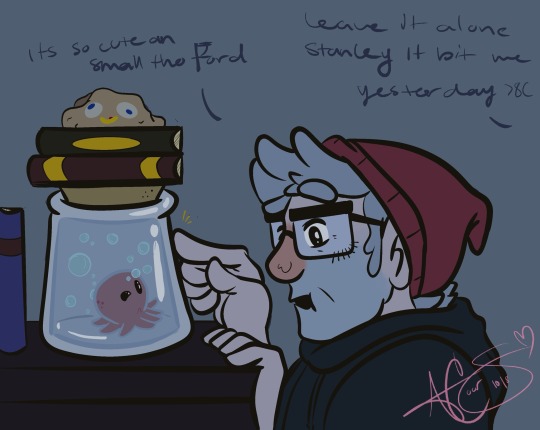
Day 8! Octopus!
Stanley I’m gonna put YOU in a bottle with books on it and shake it you’re so cute!
#gravity falls#gravity falls is a beautiful thing!#grunkle stan#my art#self love#stan#gravity falls stanley#stanley pines#stanley pines x reader#grunkle ford#grunkle stan fanart#grunkle stan x reader#sea grunks#gravity falls stan pines#hunkle stan#hunkle stan x reader#stan and ford#ford#ford pines#ford pines x reader#stanford pines#stanford pines x reader#octopus#gravity falls tober#inktober#rock fact#stan pines#stan twins#gravity falls stanford
459 notes
·
View notes
Text

♪ It's time for Fish Mollusc Fact Friday♪
The common blanket octopus is so named for the large, blanket-like iridescent webbing found between their arms - this webbing can be stretched out to give the octopus a larger silhouette, which can be used to scare away predators. However, only female blanket octopuses possess this webbing!
Male and female blanket octopuses are drastically different in appearance; females can grow to around 2m (6 ft) in size, while males only grow to around 2.5cm (1 in) long. (Imagine a fridge vs a paperclip for scale!)
Most interestingly, blanket octopuses are immune to the venom of the Portugese man o' war! Males and immature females use this to their advantage - they rip out the stinging tentacles of the man o' war, which they can then use against prey and predators!
#it's pretty mesmerising to watch them swim!#perhaps I should start a mollusc monday?#fish fact friday#my art#marine biology#octopus#blanket octopus#mollusc
263 notes
·
View notes
Text
Idk about y’all but valentines memes have been my favorite part of the holiday since I was an inappropriately young child on the internet
So I made some cephalopod themed ones for your enjoyment <3

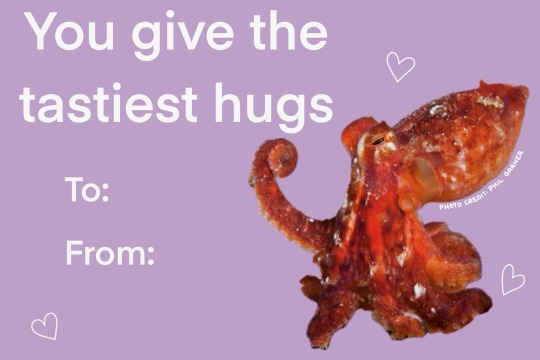




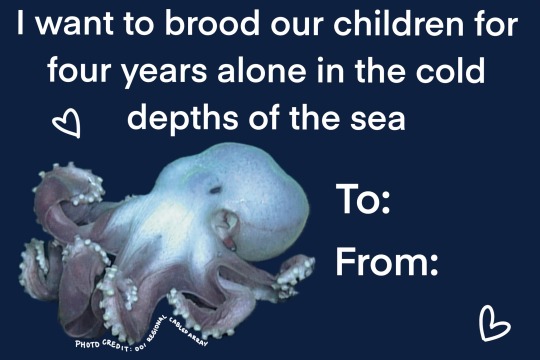


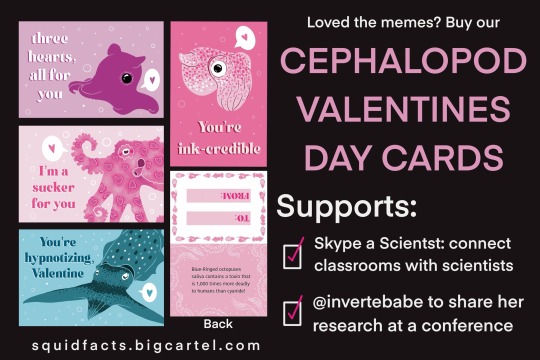
These puns are ones that did not make the cut for our actual Valentine’s Day cards shown in the last image
Purchase them at squidfacts.bigcartel.com <3
#cephalopods facts#cephalopod#cephalopods#squid#octopus#cuttlefish#nautilus#marine animals#marine biology#ocean animals#oceancore#ocean memes#marine memes#marine biology memes#valentines day#valentines cards#deep sea#marine biology shitpost
1K notes
·
View notes
Text
There's something really fundamental to me about the fact that we never actually see Sebastian's True Form as any kind of full humanoid body. Instead, we're cut down to the basics: eyes, teeth, legs, maybe the occasional clawed hand, all floating around in some loose black mist. The animal heads that we see in the memory arc flashbacks are interesting too-- a dog and a raven (or crow?), naturally, but also an octopus, a snake, a fly. Clawing and watching and grinning at all times, predatory and hungry but also, crucially, amalgamate.

This really emphasizes two fundamental aspects of Sebastian and his role in the story to me, those being:
Sebastian is an unquestionably powerful being in the universe of KURO, a point further emphasized by the fact that we can never truly know him-- not his backstory, not his fully body, not the deeper extent of his motivations or feelings or desires.
Sebastian being so undeniably inhuman is core to his relationship with Ciel, and the ways in which he both does and does not reflect/parallel both Ciel's abusers and most beloved family members.
I think you can kind of read the more indistinct aspects of Sebastian's True Form as being a kind of side effect or representation of the ways in which Ciel views him, especially early on. Again, think about the details of Sebastian that we do see at this point: eyes, mouth, shoes, hands. During his time in the cult, Ciel is objectified and sexualized, used to being watched and surveyed at all times. He is, to Sebastian, a meal, something to be preyed upon and eaten-- but also spoken to, lured in, laughed at and ridiculed and complimented. He is a child locked in a cage, trapped near the ground and thus forced to see the world from below, only ever looking up at the people surrounding him, watching their shoes as they walk around him, over him. He is held and moved, puppetted, manipulated in a very literal, physical sense. The Little Red Riding Hood comparison is very apt here, actually-- eyes to see you, hands to hold you, mouth to eat you.

Yet it is also this fundamental inhumanity that kind of makes their dynamic work at all. As this post so wonderfully puts it, Sebastian's human form is an interface, an emulation, one more body to mix up in the amalgamation of Things He Can Be so that he may better serve his new master. He doesn't really have human desires, or at least not straightforwardly. We know that he likes LARPing as a butler full time, that he is prideful and gets off on being praised (see: the circus), but he clearly isn't really attached to the specifics of that in any human way. He isn't prideful of status, or his looks, or anything that could be connected to a typical human life, because this form is just another one of many, something that can and will change in the future, and has in the past.
We know that Sebastian wants one thing: Ciel. But it is the nuances within how exactly this desire manifests itself that forms the axis that a significant chunk of their dynamic revolves around.
A really interesting aspect of KURO to me that I struggle a bit to put into words is the ways in which both Ciel and Sebastian parallel the antagonists of the series and their friends/loved ones simultaneously. I don't think I've ever read or watched a series where the line between who is a "hero" and who is a "villain" is any less clear. This is not to say that the series has no ethical values, or that there aren't Some People clearly doing worse shit than others (Baron Kelvin when I get you), but most of the main characters that we see all have some kind of fucked up or complex dynamic happening between their personal values, their relationships with others, and larger social norms.
Take Grelle in the very first true arc of the series, for example. There's a fascinating parallel that I don't think I've ever really seen anyone talk about between Grelle's immediate murder of Anne the second she fails to live up to her expectations, and the eventual consumption of Ciel at the hands of Sebastian that has been teased since the very beginning. Not only is this moment a fantastic tone-establishing moment for the rest of the series, showing firsthand the brutality that it is willing to commit against even its central characters, it's also one of the first times we get this blurring-of-the-lines moment between protagonist and antagonist. It's an ongoing theme of the series, honestly, particularly with some of the more intense enemies that they go up against-- everybody's a hypocrite, but only one side is going to win. The Circus kids were powerless and pitiful and latched onto the first kind hand that was offered to them, regardless of how they were forced to corrupt their morals in response. Maurice Cole uses and manipulates others, using his prettiness to get what he wants, after being scammed out of a future by being the second to be born. We can only solve this murder if we let these people die.
This is one of the reasons why I view Sebastian and Ciel's relationship as being so fundamentally codependent. There's been a couple posts going around talking about this, but to say it again: Sebastian is everything to Ciel, in a very literal sense. He is the predator and monster lurking in the shadows, he is the doting butler lovingly brewing his tea and picking his clothes and tucking him into bed, he is the dog biting anyone who gets near him, the demon laughing at his pain, the wife picking the best furniture for the lounge. He saved him to kill him. He's got his father's face. They're no different from anybody else, but they can't be without each other either.
Maybe it's enough that they picked each other, and continue to pick one another, doubling down as they grow nearer and nearer to the decimation. Sebastian is grooming Ciel, growing and cultivating him, but in a dynamic under which he has little to no control. Ciel is a victim, a traumatized and abused child, using every scrap of power and knowledge he can get his hands on to order his pet monster who to kill. He never changes his goals, quite literally never grows up, but he gains strength and confidence and loyalty.
They are nothing, and everything. It makes sense, doesn't it?
#astronaut rambles#kuroshits#sebaciel#kuroshitsuji#black butler#sebastian michaelis#ciel phantomhive#i Adore to no end the fact that one of seb's canon animal shadow form thingies is an octopus. btw#can we talk about that more#getting back on my tentacle seb agenda here we gooooooooooooo#and using proper caps again!!#everybody clap
101 notes
·
View notes
Text
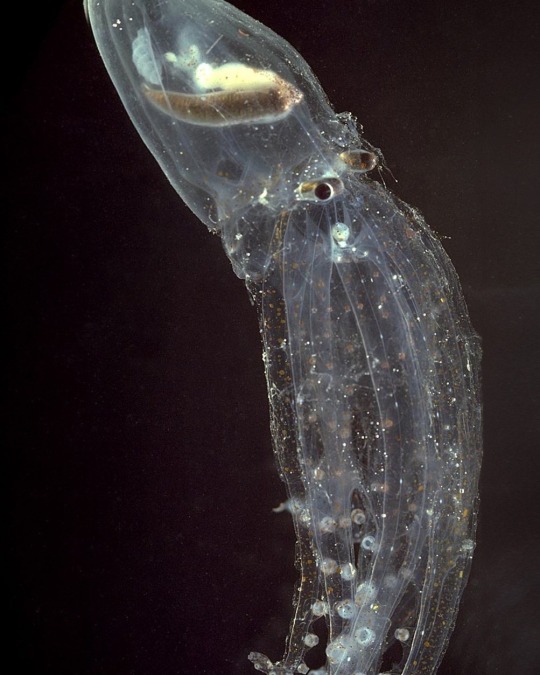
Do you ever feel… like a plastic bag drifting through the sea? You might relate to the glass octopus (Vitreledonella richardi). This cephalopod can be found in tropical and subtropical waters around the world. Named for its transparent skin, it inhabits depths of around 3,000 ft (914 m) where sunlight doesn’t penetrate. Scientists think its see-through appearance is a form of camouflage that protects it from predators and conceals it from prey!
Photo: Richard E. Young, CC BY-NC 4.0, iNautralist
#science#natural history#nature#animals#marine life#marine biology#cool animals#did you know#fact of the day#deep ocean#cephalopods#octopus#weird animals
947 notes
·
View notes
Text



Fremimimir
#my art#freminet#genshin impact#My friend told me this fun fact and all I could think of was Freminet holding an octopus and being mildly terrified yet fascinated
104 notes
·
View notes
Note
opinion on octopi? I love them lol best squishy bois
They are definitely one of my favorite marine creatures!

Grimpoteuthis or Dumbo Octopus
Here are some of my octopus posts: x x x x
#marine biology#marine ecology#animals#science#biology#animal facts#ocean#wildlife#marine life#fun facts#octopus#dumbo octopus#octopi#octopuses#cute animals#animal gifs#gifs#cute animal gifs#Grimpoteuthis
249 notes
·
View notes
Text
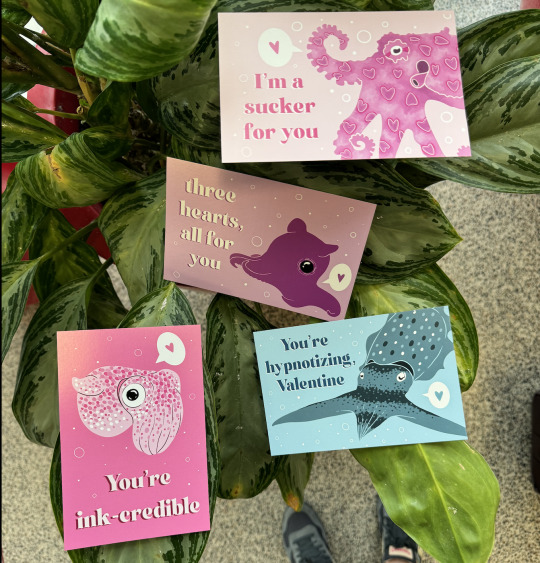

Do you like Squid Facts? 🔲Yes 🔲No
This valentines day, we thought you might need a little help from cephalopods to celebrate. Get a pack of 20 cards for your classroom, your coworkers, your neighborhood, frankly anyone who needs both a valentine AND a little bit of science to boot.
Get 'em here: https://squidfacts.bigcartel.com/
Proceeds benefit science education nonprofit Skype a Scientist AND the graduate student who designed these cards who is studying octopuses (Meg Mindlin @invertebabe!). Meg is trying to afford to get to a cephalopod neuroscience conference later this year and these cards will help her get there 🫡
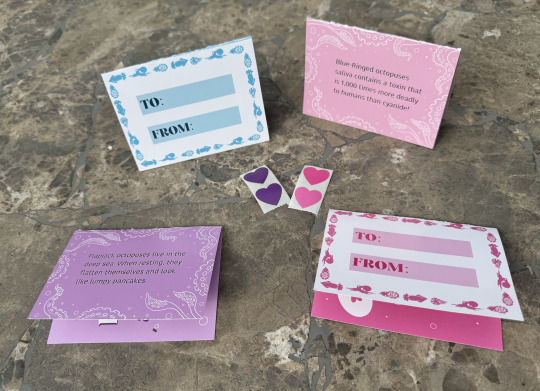
They, of course, come with the classic heart stickers, a range of shades of pink and purple included.
#Squid facts#valentines#put some science into your celebration#science communication#marine biology#ocean#marine life#octopus#flapjack octopus#blue ring octopus#cuttlefish#bobtail#bobtail squid#squid#cephalopods#sealife#scicomm#cephalopod#science
924 notes
·
View notes
Text
Wet Beast Wednesday: giant Pacific octopus
Its actually wild to me that's I've been doing this series for almost 2 years and somehow haven't covered a single octopus yet. I've done squid, cuttlefish, nautiluses, and the vampire squid, but somehow the most famous corner of the cephalopod family reunion has eluded me. Time to change that. And why not go big and cover the biggest (maybe) octopus of them all?

(Image: a giant Pacific octopus crawling on the seafloor. It is a large, red, soft-bodied invertebrate with wrinkly skin. A bulbous head contains the eyes and opening to the mantle. Attacked are eight long arms lined with suckers. End ID)
Enteroctopus dofleini is the giant pacific octopus, though genetic studies have indicated that there may be multiple distinct subspecies based on location. They are considered the largest octopus species in the world, though that may not actually be the case. Adults usually reach an arm span of 4.3 meters (14 ft) and weigh up to 15 kg (33 lbs), with some large specimens getting up to 50 kg (110 lbs). That held the record for a long time, but in 2002, a dead specimen of Haliphron atlanticus, the seven-armed octopus was pulled up and while it was incomplete, its size while alive was estimated to be 3.5 m (11 ft) from top to arm tip and 75 kg (165 lbs). Seven-armed octopi are much more elusive than giant Pacific octopi, so we don't have nearly as many specimens to go off of, but if that sample is anything to go by, they are even bigger than the GPO.

(image: divers next to a giant Pacific octopus shown from below with its arms spread, showing off the suckers and the radius of the tentacles, which is larger than the diver. End ID)
The giant Pacific octopus's anatomy is typical of an octopus, just scaled up. It has two body segments: the head and the arms. The head is bulbous and contains the organ systems, including the brain, digestive system, renal system, and all three hearts, and is covered by the mantle. The arms (not tentacles as commonly thought) are eight limbs lined with powerful suckers, each of which can be moved independently. The only hard part of an octopus's body is the beak, used to chop up food. Because the rest of the body is so malleable, an octopus can squeeze its body through any hole large enough to fit the beak. The beak is also venomous, though only a few octopi possess venom potent enough to harm a human and the GPO is not one of them. Octopi (I can rant about what the proper plural is later, but as far as I'm concerned, octopi is perfectly acceptable) along with their squid and cuttlefish relatives, have special pigment-filled cells called chromatophores lining their skin. Using muscular action, the octopus can individually widen or shrink each chromatophore to radically change its color. This is used mostly as camouflage, but can also be used as a threat display in some species (such as the blue-ringed octopus) or for communication. The GPO is usually a ruddy red color when resting. Skin texture can also be altered with muscles, but in the GPO it is usually uneven, with long lateral folds that give it a wrinkly appearance. Octopi have a siphon concealed in the mantle that is used to pass water over the gills and for propulsion.
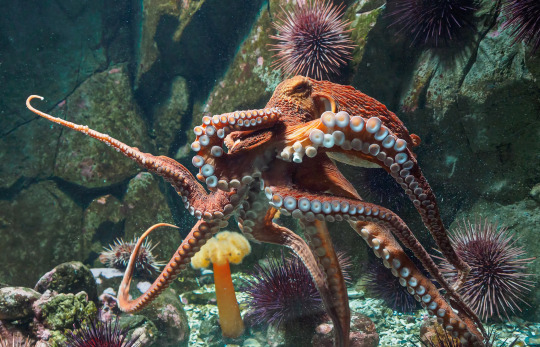
(Image: a GPO crawling through an aquarium tank. Purple sea urchins and anemones are in the background. End ID)
The giant Pacific octopus live in (surprise, surprise) the Pacific ocean. Specifically in the northern regions from the Yellow Sea in southern China, up through the eastern coast of Russia, across to Alaska, and down as far south as southern California. They are found in reefs and rocky bottoms with plenty of places to hide. The GPO occupies a middle portion of the food web. They are predators who feed on hard-shelled invertebrates, fish, and smaller cephalopods. They hunt prey as large as the spiny dogfish shark, which can grow up to 1.2 m (4 ft) and have been reported to attack and drown seagulls. In turn, they are fed on by sharks and marine mammals. Octopi are especially skilled at eating hard-shelled invertebrates like bivalves, as their powerful arms and suckers allow them to pry open the shells to get at the meat within. Octopi need to bite their food into small chunks as their brains are donut-shaped and circle the esophagus. Swallowing something too big can give them brain damage. The GPO prefers to dwell in dens, but will also hide amongst kelp or camouflaged among rocks. Dens can be spotted by looking for the discarded shells of meals piled up outside them They spend most of the day motionlessly resting (something anyone who has ever been disappointed at the octopus exhibit in the aquarium can tell you) and are most active between midnight and early morning. When active, they hunt and search for new hiding spaces. Large GPOs can travel lond distances in search of habitats and mates. Populations in Asia are known to migrate to shallow water in winter and deeper water in summer. They can remember where they've been by using visual stimuli. When threatened, they can release a cloud of toxic ink to blind attackers while they flee.

(Gif: a GPO crawling along the seafloor, showing off how the arms work together to move it. End ID)
Giant Pacific octopi live for up to five years, which makes them ancient by octopus standards. Most species only live for one year. Like all cephalopods except for nautiluses and possibly the vampire squid, giant Pacific octopi are semelparous, meaning they reproduce only once in their lives. This happens in fall and males will seek out females to mate with. Males have a modified arm called a heterocotylus that they reach into a hole in the female's mantle to deposit a packet of sperm that can be over a meter long. The female can then hold onto the packet to fertilize her eggs up to several months later. Genetic testing indicates that both males and females will mate with multiple partners. The female must find a suitable den and will lay up to 400,000 eggs in clusters attached to a hard surface. For the next 6 months, she will stay with her eggs to protect them, blowing oxygenated water over them and cleaning them of algae and other contaminants. She does not eat during this period, subsisting on her internal fat stores. By the time the eggs hatch, she will either have starved to death or will do so shortly. Males also do not survive past mating season. They also stop eating and become more prone to acting in the open, leaving them more vulnerable to predators. The newborn octopi are called pseudolarvae and are roughly the size of a grain of rice. Once hatched, they enter the water column and live amongst the zooplankton. Only a very few of the peudolarvae will survive to adulthood. The majority will succumb to disease or predation. Sexual maturity is regulated by a gland called the optic gland, which is analogous to the pituitary gland in vertebrates. Experiments have shown that females whose optic glands have been removed stop brooding their eggs and resume hunting. They also resume gaining weight and have longer lifespans.

(Image: a female GPO in her den. clusters of small, white eggs hang from the ceiling. End ID)
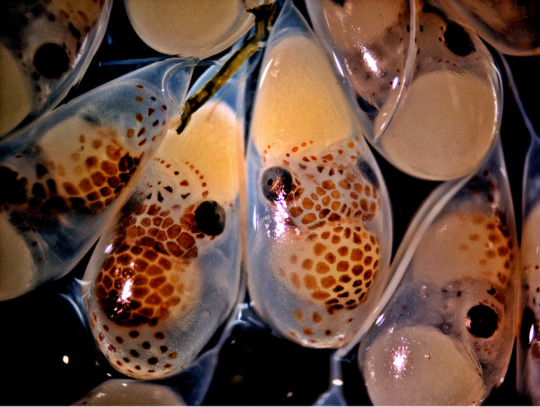
(Image: GPO eggs about ready to hatch. They are transparent, oblong capsule with the juveniles visible within. They have similar anatomy to the adults, but with visible ink sacs. End IS)
Octopi are the most intelligent of all invertebrates. They are capable of solving puzzles based on trial and error. Indeed, those living in aquariums are often given puzzles to solve as a form of enrichment. Aquarium workers have reported that giant Pacific octopi can recognize individual people and can hold grudges. Captive octopi are notorious for doing things like disabling mechanisms in their tanks, pranking certain people, and even escaping their tanks to visit other ones, then returning to theirs before anyone comes by to catch them. They are capable of tool use and can use shells and human-made objects to build defensive structures around their dens and some small species use shells or other objects as armor. Brain surface area often correlates to intelligence in areas and octopi have the highest ratio of all invertebrates. They are a rare example of an invertebrate whose brains are wrinkled the way those of tetrapods are. Only about a third of all the neurons within the nervous system are located in the brain. There are also major nerve clusters in each arm. It has been said that the arms have brains of their own, though this is not entirely accurate. The arms are capable of independent action, though learning happens in the brain. The arm brains also work to process the massive amount of sensory data they gather. Even a severed arm can act independently until it starves. There are videos out there of uncooked or undercooked octopus arms moving around on plates or grabbing onto diner's faces.

(Image: a GPO in an aquarium being given food in a jack-o-lantern as a form of enrichment. End ID)
The giant Pacific octopus is classified as least concern by the IUCN, meaning they are not at risk of extinction. They are considered abundant through their range, though they are at higher risk in some locations. GPOs are also harvested for seafood, being popular throughout their range and beyond. The GPO, along with the big blue and common octopi, are the most commonly eaten species in the Pacific. Pollution, climate change, and ocean acidification are also known to be threats to octopi. A threat that doesn't exist anymore is the "sport" of octopus wrestling. This involves divers grabbing octopi and trying to pull them to the surface, with GPOs targeted due to their size. The octopus was an entirely unwilling participant in this, they are very shy animals that prefer to flee rather than fight. Fortunately, this form of recreational animal abuse doesn't really exist anymore.
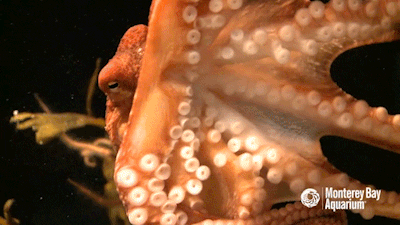
(Gif: a GPO in an aquarium crawling along the glass. This shows how each sucker can move independently and work together to move the animal. End ID)
#wet beast wednesday#giant pacific octopus#octopus#cephalopod#mollusk#molluscs#invertebrates#invertiblr#marine biology#biology#ecology#zoology#animal facts#sea creatures#marine life#marine animals#sea animals#informative#educational#image described
146 notes
·
View notes
Text

Fast Fauna Facts #3 - Winged Argonaut (Argonauta hians)
Family: Argonaut Family (Argonautidae)
IUCN Conservation Status: Least Concern
Like the other small octopuses in the argonaut family many Winged Argonauts appear to have spiral-shaped external shells similar to those of nautiluses or ammonites, but this isn't quite the case - what appears to be an argonaut's shell is only seen in adult females, and is actually a thin-walled, calcium-based case secreted from and held by a specialised pair of arms in order to carry fertilized eggs until they hatch. Found in non-polar waters worldwide, Winged Argonauts are found mainly near the surface in the open ocean (in contrast to most octopuses, which are bottom-dwellers,) feeding on small floating invertebrates and often using their suction cups to cling to flotsam or larger animals (sometimes including other argonauts) for protection; when faced with a predator, they may attempt to position the animal they're riding on between them and the perceived threat to act as a meat shield.
-----------------------------------------------------
Image Source: Here
<-Previous (Parrot Waxcap) I Next (Pink Jasmine) ->
#fast fauna facts#Winged argonaut#argonaut#argonauts#zoology#biology#teuthology#malacology#mollusk#mollusks#mollusc#molluscs#cephalopd#cephalopods#octopus#animal#animals#wildlife#marine biology
251 notes
·
View notes
Text

Black Dahlias and Sunflowers
Got myself a physical version of Tangle and Whisper and I liked the covers so much that I got an idea to do art of Twill in this style, first time doing shading like this and I'm rather proud of it!
#fun fact: black dahlias mean betrayal and sadness while sunflowers overall mean happiness and joy#sonic fanart#my art#art#oc#sonic#deer#sonic fandom#furry oc#original character#sonic tangle#tangle the lemur#tangle and whisper#tangle#sonic mimic#mimic the octopus#mimic#sonic duo#duo the cat#myart#sonic oc#sonic art#sonic idw#idw sonic
71 notes
·
View notes
Text

♪ It's time for Fish Mollusc Fact Friday! ♪
Dumbo octopuses are finned octopuses characterised by the two large flaps above their eyes - these resemble the ears of Dumbo the Elephant, which they are named after!
They are the deepest-living of all known octopuses, and move slowly along the seafloor by using their arms and flaps. Unlike most other octopuses, they do not have an ink sac due to there being fewer predators in the deep sea!
#the evnautilus footage of this octopus is just *chef's kiss*#dumbo octopus#fishblr#my art#marine biology#fish fact friday#technically not a fish but I think they're still pretty neat
166 notes
·
View notes